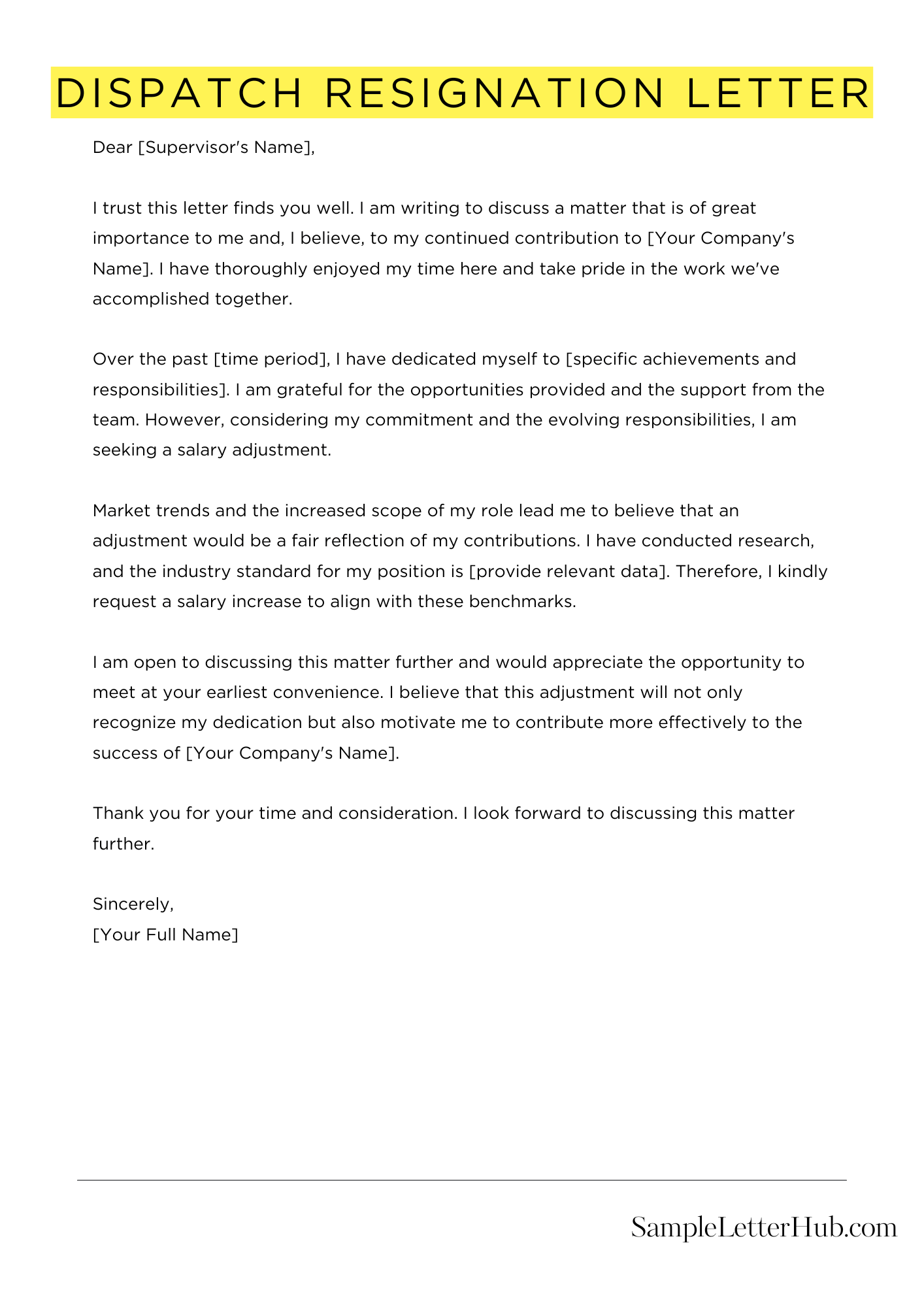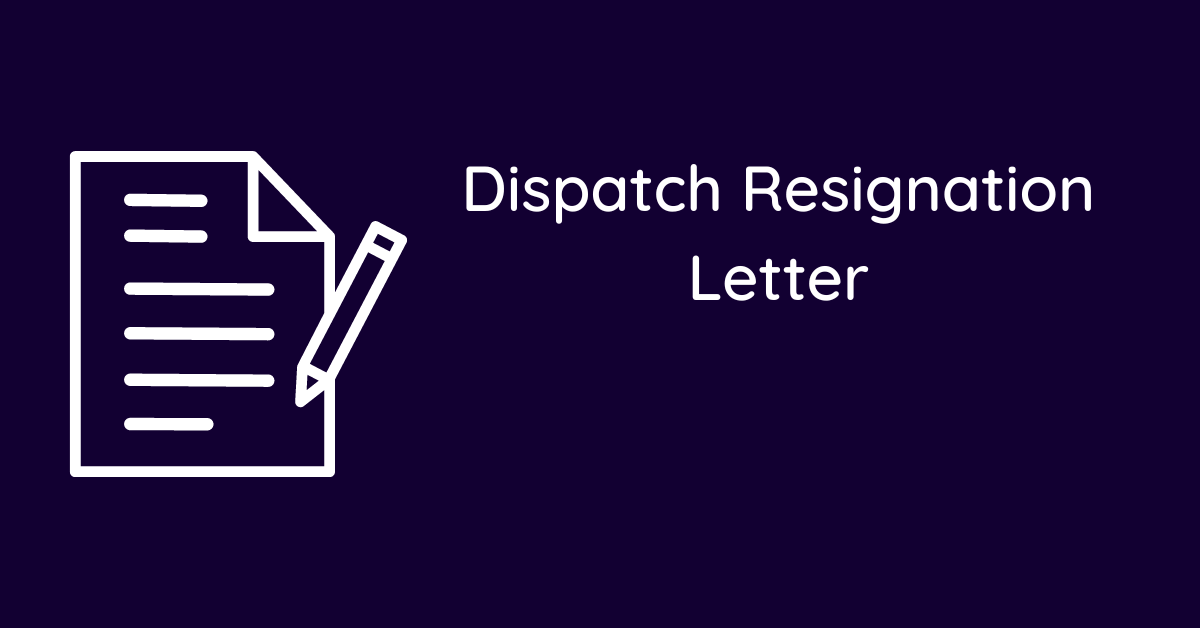It’s never easy to write a dispatch resignation letter. You want to be polite and humble, but you also want to make sure that your letter is clear and professional. That’s why we’re sharing an example of a dispatch resignation letter with you today.
One way to leave a job is to write a clear and professional resignation letter explaining your decision to leave. This letter should be polite and humble in tone, and it should thank your employer for the opportunity to work for them. It should also state your last date of employment.
We’ve included a template/example dispatch resignation letter below that you can use as a starting point. Feel free to adapt it to your own needs.
Dispatch Resignation Letter
Dear [Recipient Name],
Please accept this letter as formal notification that I will be resigning from my position as [Your Position] at [Company Name], effective [Your Last Date of Employment].
I have enjoyed my time at [Company Name] and appreciate the opportunities and experiences I have gained during my tenure. I wish the company and my colleagues all the best in the future.
I will do everything I can to ensure a smooth transition during my remaining time with the company.
Thank you for your support and guidance.
Sincerely,
[Your Signature]
Short Dispatch Resignation Letter Sample
Please accept this letter as formal notification that I am resigning from my position as Dispatch at [Company Name]. My last day of employment will be [Your Last Day]. Thank you for the opportunity to grow and learn during my time here. I wish you and the company continued success. I am happy to assist in the transition process to ensure a smooth handover of my responsibilities.
I wish you all the best with your dispatch resignation letter.
When it’s time to say farewell, expressing your gratitude and best wishes can make the transition smoother:

How to Write a Dispatch Resignation Letter
1. Craft a Clear and Concise Opening
Begin your letter with a formal salutation, such as “Dear [Manager’s Name].” State your intention to resign from your position as a dispatcher, providing your last date of employment. Keep this section brief and to the point.
2. Express Gratitude and Appreciation
Take a moment to express your gratitude for the opportunities and experiences you’ve gained during your time with the company. Mention specific individuals or projects that have made a positive impact on your career. This shows that you value the relationships you’ve built and the contributions you’ve made.
3. State Your Reasons for Leaving
While it’s not necessary to go into great detail, you can briefly state your reasons for leaving. Be honest and professional, focusing on positive aspects such as career growth or new opportunities. Avoid being negative or critical of the company.
4. Offer to Assist in the Transition
If possible, offer to assist in the transition process. This could include training your replacement or providing documentation on your responsibilities. This gesture shows that you’re committed to ensuring a smooth handover and that you care about the company’s success.
5. Close with a Professional Tone
End your letter with a formal closing, such as “Sincerely” or “Best regards.” You can also include a personal touch, such as wishing the company well in the future. Keep your tone professional and respectful, even if you’re leaving for a competitor.
6 Most Frequently Asked Questions About Dispatching a Resignation Letter
When it comes to leaving a job, writing a resignation letter is a crucial step. Here are the six most frequently asked questions about dispatching a resignation letter, along with their answers:
1. When should I submit my resignation letter?
It’s generally advisable to give your employer at least two weeks’ notice, or more if your position requires a longer handover period. This provides ample time for your employer to find a replacement and ensure a smooth transition.
2. What should I include in my resignation letter?
Your resignation letter should include the following key elements:
- A clear statement of your intent to resign
- Your last date of employment
- A brief expression of gratitude for the opportunity to work at the company
- Any outstanding tasks or projects you’re willing to assist with during the transition
3. How should I format my resignation letter?
Use a professional font and font size, and keep the letter concise and to the point. Include your contact information at the top of the letter, and sign and date it at the bottom.
4. Should I submit my resignation letter in person or via email?
In most cases, it’s best to submit your resignation letter in person. This allows you to have a face-to-face conversation with your manager and express your appreciation in person. However, if you’re unable to meet in person, you can also submit your letter via email.
5. What if I’m feeling nervous about submitting my resignation letter?
It’s perfectly normal to feel nervous about submitting your resignation letter. Remember that you’re not alone, and that your manager has likely been through this process many times before. Be confident in your decision and focus on expressing your gratitude for the opportunity to work at the company.
6. What should I do after I submit my resignation letter?
Once you’ve submitted your resignation letter, it’s important to maintain a positive and professional attitude. Continue to perform your job duties to the best of your ability, and assist with the transition in any way you can.
Before making the decision to resign from your job, it’s essential to consider the legal aspects:
Understanding your emotions after quitting your job is important. Explore why you might be feeling sad:
Related
- Resignation letter sample
- Forced resignation letter
- Resignation letter due to going abroad
- Resignation letter due to marriage
- Resignation letter due to other opportunity
- Resignation letter due to mistake

